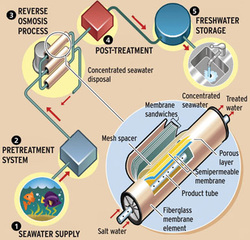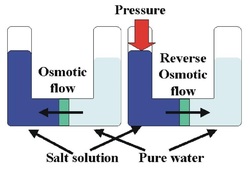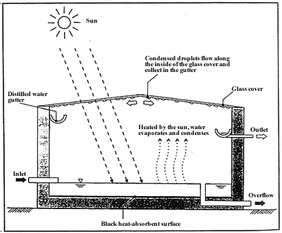Water Sustainability
Desalination
Desalination Process
Distillation using Solar Energy
- Desalination describes a range of processes which are used to reduce the amount of dissolved solids in water. As a means of producing potable water, desalination is usually an expensive option. It is often associated with electricity generation plants, from which both electricity and waste heat are available. This technical brief outlines of the processes and techniques involved, but also presents a low-cost methods of desalination by distillation.
- Who Uses Desalination?
Of the whole desalination capacity in the world, 50% is in the Middle East, 20% is in North America, 12% to 14% is in Europe and in comparison to that, less than 1% is in Australia.
There are several methods of water desalination. Of the desalination methods available, the two main ones are:
- reverse osmosis
- distillation followed by condensation - Reverse Osmosis
Osmosis is a technique which plants use to absorb water from the soil. Dilute and more concentrated solutions are separated by a semi-permeable membrane, which acts like a very fine filter. The membrane allows water molecules to pass, but prevents movement of salt or other dissolved chemical molecules.
If two saline solutions (or water and a saline solution) are separated only by a semi-permeable membrane, there will be a transfer of water through the membrane to the more concentrated saline solution until a stable condition is reached.
By applying pressure to the salt water solution, the process can be reversed, and water molecules from the salt-water solution can be forced through the other side of the membrane. - Distillation
The collection of water by distillation and condensation is a survival technique which can be usedto collect small quantities of water from the ground. A hole is dug in the ground, and a cup or bowlis placed in the bottom of the hole. A sheet of plastic is stretched across the hole, its edges areweighted with soil to hold it in place, and a small stone is placed in the centre. Water evaporatesfrom the soil, condenses on the underside of the plastic sheet, and collects in the cup or bowl
Solar energy can be used to evaporate water from salt water for household or community water supplies by constructing sealed units covered with glassThere are problems with these units: growth of algae on the underside of the glass sheet must be controlled, and the unit must be effectively sealed.



